In Part One of my quest to walk between both of Manhattan’s cable-stayed bridges, I meandered from Rockefeller University on the East River just north of the Queensboro (that is the only name I call that bridge) west through the Fifties, passing several unsung landmarks such as the Central Synagogue, DuMont Tower, and Fisk-Harkness House along the way. On this post I’ll go over the rest of the trip, through the northern Times Square area and Hell’s Kitchen…
TOUR ROUTE: BETWEEN CABLE-STAYED BRIDGES

The WINTER GARDEN, at Broadway and West 50th Street, was the longtime home of Cats and the current longtime home of Mamma Mia! However, it is also a throwback to a time before Times Square was Times Square — when this was called Longacre Square and was the home of horse and carriage dealers, not showbiz.
It was built as the American Horse Exchange (owned by William K. Vanderbilt) between 1881-1883, becoming the Winter Garden in 1911; its horse ring was adapted into a stage by the time of its final remodeling in 1923. The debut performances of West Side Story, Funny Girl, Mame, Follies and 42nd Street took place here.
In 1997-1998, another remnant of Longacre Square’s equine past was briefly uncovered at Broadway and West 47th.
For years I had labored under the idea that the two busts (one above the door, the other on the top floor) that you can see on the BRILL BUILDING, NW corner of Broadway and West 49th, honored someone in the Brill family for which the building is named. I was wrong about that. They honor the builder’s son.
In 1929, the Brill Brothers sublet the site to developer Abraham Lefcourt to construct a new building by November 1931. Originally, Lefcourt planned to build a tower that would rival the Chrysler Building then rising on Lexington Avenue and East 42nd in height. But, two disasters befell the developer; the first was the stock market crash and economic cliff-fall of October 1929, and the other was the death of his 17-year-old son, Alan, from anemia. The building, known as the Abraham Lefcourt Building, was scaled down to a 10-story Art Deco structure that bear two unmarked busts of Alan. Abraham, meanwhile, defaulted on his sublease and the Brill Building acquired its current name in 1932. Abraham himself passed away that year.
Most pop music fans know the Brill Building as a center of music publishing where, by the 1960s, hit after hit was turned out by songwriters Neil Sedaka, Howard Greenfield, Carole King and Gerry Goffin, but it had been home to big bands and jazz bands of the likes of the Dorsey Brothers and Duke Ellington by the 1940s.
“Built with a Broken Heart” [Christopher Gray, New York Times]
“Always Magic in the Air” [Ken Emerson]
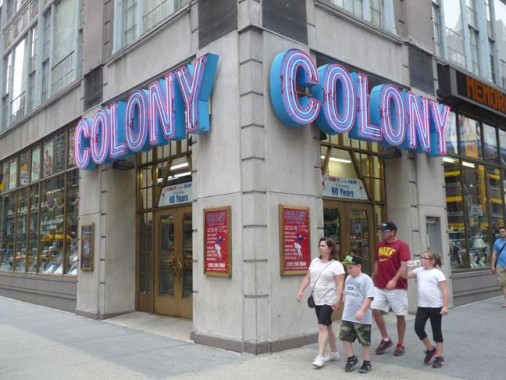

Colony Music Center has been on the ground floor of the Brill Building and has been in business since 1948. When I first started buying music in the late 1970s, Colony was where I went to track down hard-to-find items, before I learned about all the hole in the wall record stores I later frequented on West 8th and St. Marks Place. Colony, though, predated Tower (where I also spent a lot of time) and darned if it didn’t outlast it.

This particular Sbarro, on Broadway and West 49th, has taken to calling itself “Mama Sbarro’s”, perhaps in tribute to the long-gone Mama Leone’s. Sbarro now has hundreds of locations, but began as a humble pizzera/pasticceria on 17th Avenue and 65th in Bensonhurst, Brooklyn.

Many Broadway theaters are venerable and have been landmarked, or should be. The AMBASSADOR, 219 West 49th, was built between 1919 and 1921 by prolific theater designer Herbert J. Krapp; only its interior has been landmarked; the structure is unusual in that it is situated diagonally on its site to fit the maximum number of seats possible [wikipedia]. Chicago has played here since 2003.
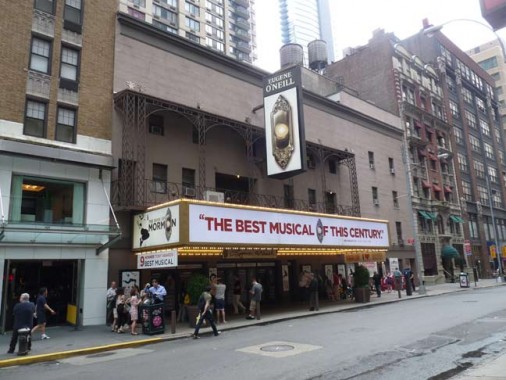
The EUGENE O’NEILL THEATRE, when opened in 1925 at 230-238 West 49th [arch. Krapp], was named the Forrest (after Edwin Forrest, the great 19th Century actor). It was renamed the Coronet in 1945 and received its present name, honoring the playwright, in 1959. The Book of Mormon, a spoof by the creators of the South Park TV show, here since 2011, has acheived box-office records for the theatre.

At 242 West 49th, the MAYFAIR is a budget hotel with smallish rooms originally built in the 19-aughts to house actors appearing in local productions.
ST. MALACHY’S CHURCH, at 239 West 49th, is known as the Actors’ Church. Jim Naureckas of Songlines explains why:
This neo-Gothic Roman Catholic church was built in 1902; the construction of an Actor’s Chapel below the main church recognized its function as a spiritual home for Catholic show folk. Among the many who worshipped here were George M. Cohan, Spencer Tracy, Perry Como, Rosalind Russell, Danny Thomas, Bob Hope, Ricardo Montalban and Pat O’Brien. The funeral of Rudolph Valentino, held here on August 30, 1926, attracted 100,000 mourners. Joan Crawford, Fred Allen and Jimmy Durante were all married here.

Shifting to West 48th Street between 8th and 9th Avenues, at 328 we find the former PS 17, now the Midtown West School (PS 212) and Professional Performing Arts School of NYC. The school was founded in 1990 for students who wished to work professionally in the arts. Notable graduates include Britney Spears, Claire Danes, Alicia Keys and Jesse Eisenberg (who played Facebook king Mark Zuckerberg in “The Social Network”.



CLINTON COMMUNITY GARDEN, West 48th between 8th and 9th Avenues.
In 1984, the Clinton Community Garden became the first community garden in New York City to be granted permanent parkland status. This was a big moment both for our garden and the future of community gardening in the city. The story of our garden, however, starts some seven years earlier when a group of residents on West 48th Street decided to do something about the garbage heap in the middle of their block. Abandoned for 28 years, the lot held the remains of two tenement buildings, rusted-out cars, and ever-growing piles of trash, and was generally a magnet for illegal activity in a neighborhood that had its share of crime and misery. But the neighbors spotted some wild tomato plants growing out of the rubble and saw a chance for something else.
The city-owned property was leased through Operation GreenThumb in 1979 and organized into two sections, a public front garden with a lawn and flower beds and a back area for individual plots. Over the next several years, the back garden was expanded from the west to the east, so that 108 garden plots were eventually created. Paths were built from salvaged brick, and fences and gates were put in to protect the garden and separate the public area from the plots in the back. Stone benches were made from recycled slabs of slate and concrete blocks. Clinton Community Garden
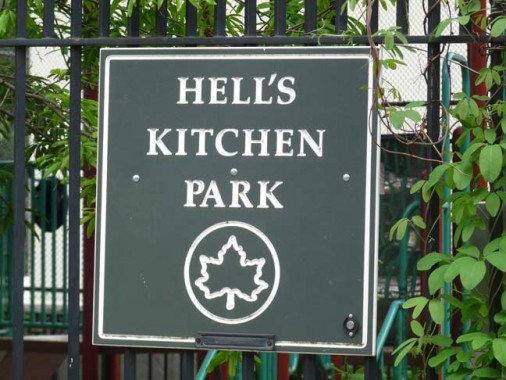
Hell’s Kitchen Park sign, 10th Avenue and West 48th. There’s a long-running tug of war between local residents and developers, some of whom prefer to call this neighborhood west of Times Square Clinton, after DeWitt Clinton (1769-1828) who, among many other positions, was a U.S. Senator, Mayor of New York City and Governor of New York State; and other locals, who like the more informal Hell’s Kitchen.
Local historian Mary Clark: [the name] first appeared in print on September 22, 1881 when a New York Times reporter went to the West 30s with a police guide to get details of a multiple murder there. He referred to a particularly infamous tenement at 39th Street and 10th Avenue as “Hell’s Kitchen,” and said that the entire section was “probably the lowest and filthiest in the city.” According to this version, 39th Street between 9th and 10th Avenues became known as Hell’s Kitchen and the name was later expanded to the surrounding streets. Another version ascribes the name’s origins to a German restaurant in the area known as Heil’s Kitchen, after its proprietors. But the most common version traces it to the story of Dutch Fred The Cop, a veteran policeman, who with his rookie partner, was watching a small riot on West 39th Street near 10th Avenue. The rookie is supposed to have said, “This place is hell itself,” to which Fred replied, “Hell’s a mild climate. This is Hell’s Kitchen.” wikipedia
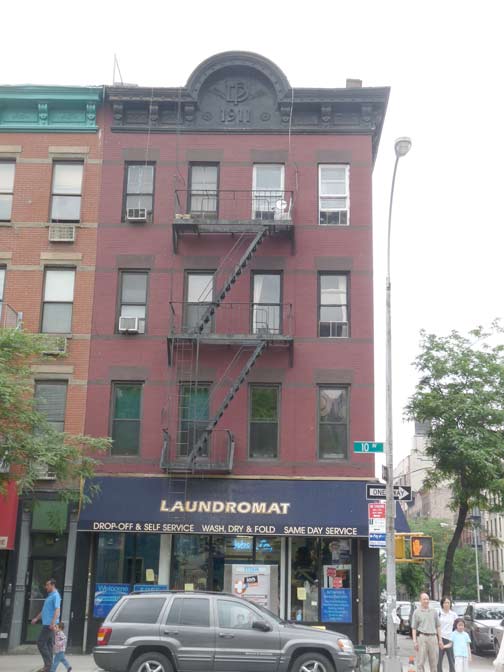
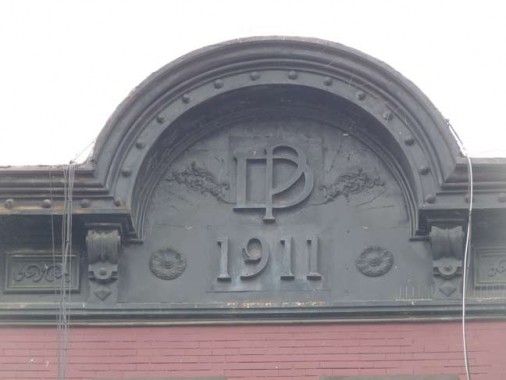
This walk up apartment building at West 48th and 10th handily notes the date of construction on the pediment as many of its time period do. The “DP” is probably the initials of the first owner or the architect.
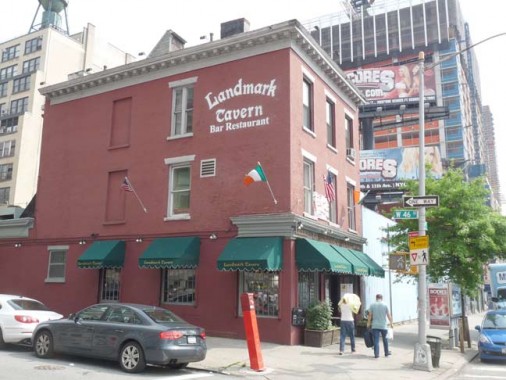

I’ve only visited the Landmark Tavern at West 46th and 11th Avenue once, tucked on the far west side as it is. The slaughterhouses, glue factories, stockyards, lumberyards and industries where workmen used to get their liquid lunch from the Landmark are mostly gone but the old place soldiers on. It was founded by Irish immigrant Patrick H. Carley in 1868, when 11th Avenue faced the Hudson River. It was a speakeasy from 1919-1932 in the Prohibition era.
It’s something of a formal place these days, believe it or not, and has a serious menu, not just burgers and chicken.
This brings me to the end of the tour, the short cable-stayed bridge bringing foot traffic over 12th Avenue to the USS Intrepid Museum, as well as the Circle Line at West 46th Street. It was constructed by the Yonkers Contracting Company, using a nautical theme, and was opened in May 2003.
The bridge was planned in the late 90’s, as the blighted Hudson River waterfront gained biking paths and walkways as part of Hudson River Park. Tour buses that had dropped visitors at the front door of the Intrepid museum were no longer able to do so, since their access was blocked by the new bike path, and state transportation planners deemed a pedestrian walkway the best solution to the problem.
“We wanted a culturally significant attraction, a signature bridge,” said Jennifer Nelson, a spokeswoman for the State Department of Transportation. The bridge is strung from cables, making it appear to be a miniature version of a suspension bridge.
But the state’s ambitions in bridge design led to problems. Workers hit bedrock when they sank pilings, and steel railings had to be returned and recast. Industrial contamination [had] to be removed from what will be the tour-bus parking area. NY Times
Will we have any additional cable-stayed bridges in NYC? We shall see.
6/10/12

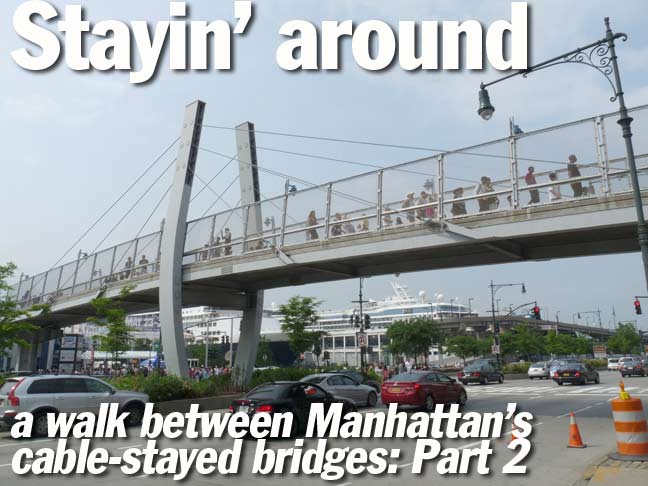
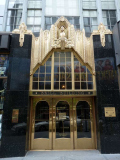
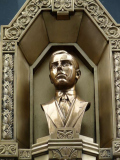
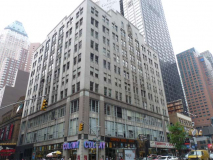
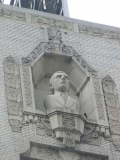
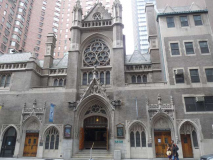
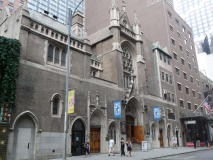

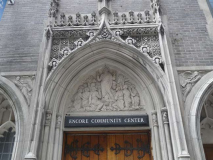

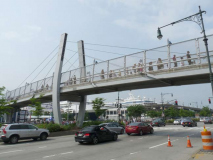
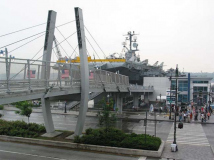
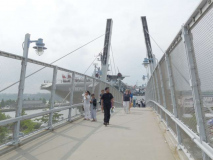
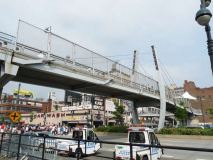
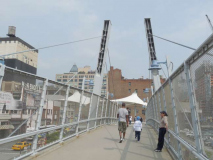
15 comments
Great info as always, thanks. There’s another such bridge over the FDR at east 63rd street: http://www.nytimes.com/1999/12/12/realestate/postings-rockefeller-university-s-campus-bridge-over-east-63rd-street.html. It’s been there over ten years and I believe it’s also a cable-stayed bridge. Here’s a photo: http://www.flickr.com/photos/jag9889/2924917111/ looking south you see the Roosevelt Island tram and the QB bridge.
OOPS! just reread the first part of your article… my mistake! Of course you knew this… sorry!
You say the bridge was built for NYC DOT and then quote a spokesperson from NY State DOT. I think it was built for the state.
You got me there. I’ll fix it.
I remember visiting the Ambassador Theatre when it was being rented by Dumont for their studio audience productions such as Mike Stokey’s Pantomime Quiz
Did not know that info one the Winter Garden. I love it when you post equine-related sites!
Nice to see the Mayfair Hotel. I wrote a bit about this in 2007, here’s a link with pictures them 2007 and 1989: http://neilstimemachine.blogspot.com/2007/09/mayfair-hotel.html
The shop unit to the right of Colony Music in the Brill Building was for many years Jack Dempseys famous Restaurant
The network referred to the 49th Street location as the DuMont Ambassador TeleTheatre. The home of “The Honeymooners” was the DuMont Adelphi TeleTheatre on 54th between Sixth and Seventh, demolished for New York Hilton.
Wasn’t Lou Walter’s Latin Quarter night club on the second floor at Bdwy and 49th street site where the Sbarro is now?
It’s amazing how new neighborhoods are “created” and names change. I have seen some real estate broker’s listings for the area given as “North Chelsea” because that is more appealing to some of the more gentrified folks than does “Hell’s Kitchen”.
Colony Music moved to the Brill Building in 1970. Its original name and address was Colony Music & Sport Shop, 1671 Broadway at 52nd Street.
Thanks for the info.
I remember reading that Streetscapes column on the Brill Building when it first ran. Nice throw-in.
It’s the Queensboro Bridge and it’s Hell’s Kitchen, although I’m sure The Westies would be priced out these days. Great work, as always.
It’s interesting that you have pictures of the Landmark tavern. When I lived in Hell’s kitchen in the early eighties, it was a fabulous restaurant and always crowded, even though you risked your life walking to it from almost anywhere.
They had homemade Irish Soda bread that was to die for.
Went there a couple of years ago and it really is not very good at all. Kind of like diner level food and the soda bread is still there, but it is not good at all.